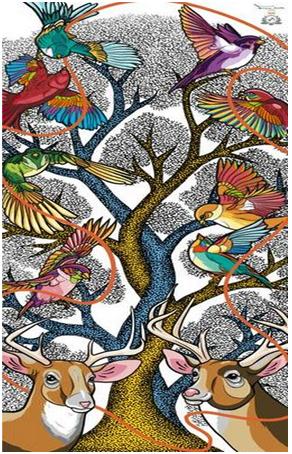Gond art in the street culture of Singapore
- Posted By
10Pointer
- Categories
History & Culture
- Published
28th Jan, 2021
-
Context
Recently, the creation ‘Dancing in Unison’ was unveiled in Little India in Singapore. The project brings India’s Gond art to the street culture of Singapore.
The Project
- One of Singapore’s tallest murals – the recently-unveiled ‘Dancing in Unison’ – borrows from the iconic imagery of both India’s Gond art and Singapore’s contemporary art.
- It was created by Indian Gond artist Bhajju Shyam and Singaporean artist Sam Lo for Singapore Tourism Board (STB) and St+art India Foundation (St+art), the collaborative artwork in Little India, Singapore.

Gond Art
- Gond paintings are a form of painting from folk and tribal art that is practiced by one of the largest tribes in India with whom it shares its name.
- States: Gond paintings are considered to be from predominantly from Madhya Pradesh, it is also quite common in Andhra Pradesh, Maharashtra, Chhatisgarh and Odisha.
- Gond art has become so predominant that the Government of India has stepped in to preserve their art form for future generations to enjoy.
- Pardhan Gonds who traditionally served as priests are popularly considered the most prominent and well renowned for their artistic skills, in painting and even music and performing arts.
Features of Art
- Subjects of Art: Trees, animals, birds and other environmental representation are probably the most recognizable subject matter in their visual art practice. From mythological tales and oral histories to traditional songs, natural surroundings, important events, and rituals are depicted in the art.
- Base of Art: It is a common belief in the Gond community that a good image can earn good luck. This belief is visible in the houses of the community. Brightly painted walls, windows and even floors, replete with traditional icons and motifs are a common sight. Canvas or a cloth, or even chart paper along with basic paint is all that is required to start making a Gond painting.
- Line and dot technique: The artists first zero-in on a single theme or a simple subject and then begin the process of painting. One of the most noticeable and easily recognizable features of Gond painting is the line and dot technique used to create entire paintings.
- Material used: A mix of natural colours is used from earthen materials such as wooden coal, tree sap, red soil, sem leaves and even cow dung.
Gond Tribe
- The Gonds are said to be the largest tribal, or Adivasi Community in India.
- The community’s roots can be traced back to the pre-Aryan age.
- Belonging largely to Deccan India, the Gond community has settled in regions spanning across northern Andhra Pradesh, eastern Maharashtra and Madhya Pradesh, Jharkhand and western Orissa.
- The 2001 census the figure was nearly 11 million.
- They speak the Gondi language which belongs to Dravidian language family.
|
